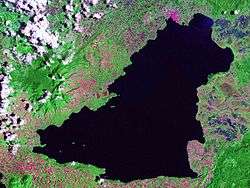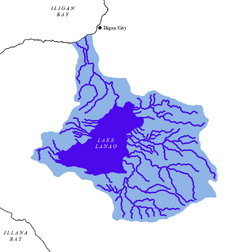Lake Lanao
Lake Lanao (Maranao: Ranao or Ranaw)[1] is a large ancient lake[2] in the Philippines, located in Lanao del Sur province in the country's southern island of Mindanao. With a surface area of 340 km2 (130 sq mi),[1] it is the largest lake in Mindanao, and the second largest lake in the Philippines and counted as one of the 15 ancient lakes in the world. Scholars have been pushing for the lake's inclusion in the UNESCO World Heritage List.[2]
| Lake Lanao | |
|---|---|
 Landsat photo | |
.svg.png) Lake Lanao Location within the Philippines .svg.png) Lake Lanao Lake Lanao (Philippines) | |
 Lake Lanao-Agus River watershed map | |
| Location | Lanao del Sur |
| Coordinates | 7°53′31″N 124°15′09″E |
| Lake type | Ancient lake, Rift lake |
| Primary inflows | 4 tributaries |
| Primary outflows | Agus River |
| Basin countries | Philippines |
| Max. length | 33 km (21 mi) |
| Max. width | 20 km (12 mi) |
| Surface area | 334 km2 (129 sq mi)[1] |
| Average depth | 60.3 m (198 ft)[1] |
| Max. depth | 112 m (367 ft)[1] |
| Shore length1 | 115 km (71 mi) |
| Surface elevation | 700 m (2,300 ft) |
| Settlements | |
| 1 Shore length is not a well-defined measure. | |
History
In 1965, Lake Lanao has been renamed by Republic Act No. 4260 then repealed by Republic Act No. 6434 in 1972.[3][4]
In Section 22 of Article XIII of the Republic Act 11054, the exclusion of this lake into the jurisdiction of the Bangsamoro Autonomous Region in Muslim Mindanao, Maranao people demands the inclusion of this lake into the Bangsamoro Organic Law.[5]
Physical characteristics
The lake was formed by the tectonic-volcanic damming of a basin between two mountain ranges and the collapse of a large volcano. It has a maximum depth of 122 m (400 ft), and a mean depth of 60.3 m (198 ft). The basin is shallowest towards the north and gets progressively deeper towards the south.[1]
The lake is fed by four rivers. Its only outlet is the Agus River, which flows northwest into Iligan Bay via two channels, one over the Maria Cristina Falls and the other over the Tinago Falls. A hydroelectric plant installed on the Lanao Lake and Agus River system generates 70% of the electricity used by the people of Mindanao.[1]
The lake is a home of myths and legends of the Meranaw tribe. The name Meranaw was derived from the name of the lake and it means "the people living around the lake".
Biodiversity
Lake Lanao was proclaimed as a watershed reservation in 1992 through Presidential Proclamation 971 to ensure protection of forest cover and water yield for hydropower, irrigation and domestic use.
The lake is (or was) home to 18 endemic species of cyprinid fish in the genus Barbodes (most were formerly in Puntius).[6] It also supports a large number of waterfowl.[1] An investigations in 1992 only managed to locate three of the endemic fish species,[7] and only two (Barbodes lindog and B. tumba) were located in 2008.[6] It is believed that overfishing, pollution and competition from introduced species caused the extinction of the remaining.[6][7][8][9] In October 2006, a study from the Mindanao State University discovered massive algae contamination in Lake Lanao.[10] Initially, poor sewage and agricultural waste management were seen as the culprit to the contamination. However, the Department of Agriculture and the Bureau of Fisheries and Aquatic Resources stated that soil erosion from indiscriminate logging and extensive land use and farming are the problems that caused the algae contamination.[1] The freshwater crab Sundathelphusa wolterecki (Parathelphusidae) is endemic to the lake region.[11]
The 18 endemic cyprinid species of Lake Lanao:
- Barbodes amarus Herre (pait; dipura)
- Barbodes baoulan Herre ** (baolan)
- Barbodes binotatus Valenciennes (Pait sah Gandamatu)
- Barbodes clemensi Herre (bagangan)
- Barbodes disa Herre ** (Diza)
- Barbodes flavifuscus Herre (tumba)
- Barbodes katolo Herre (katolo)
- Barbodes lanaoensis Herre (kundur)
- Barbodes lindog Herre ** (lindog)
- Barbodes manalak Herre ** (manalak)
- Barbodes pachycheilus Herre (Bongkaong)
- Barbodes palaemophagus Herre (bitungu)
- Barbodes palata Herre ** (palata)
- Barbodes resimus Herre * (bagangan sa erungan)
- Barbodes sirang Herre sirang; (Tumaginting)
- Barbodes tras Herre (tras)
- Barbodes truncatulus Herre (bitungu)
- Barbodes tumba Regan (tumba)
Notes:
* — Biggest native species in Lake Lanao
** — Species of high commercial value
In culture
A Maranao myth describes the formation of the lake.[1][12] Long ago, there was a polity known as Mantapoli centered in Lake Lanao. The people of the polity increased in population due to advancements in many fields. Because of the sudden growth in population and power, the equilibrium between Sebangan (east) and Sedpan (west) was broken. This problem soon came to the attention of archangel Diabarail (for Muslim Maranaos or Gabriel for Christian Maranaos). Afterwards, Diabarail went to heaven and told Allah the news. Sohora, the vice of Allah, advised Diabarail to go to seven regions beneath the earth and seven regions in the sky to summon the angels. Sohora also said that when Allah fully establishes the barahana (solar eclipse), they will remove Mantapoli from its location and transfer it into the center of the world. When the angels were summoned and the barahana made, Mantapoli was soon teleported into the earth's center, leaving a vast hole in its former location. The hole eventually filled with water and turned into a deep blue-colored lake. When Diabarail saw the tides of water, he immediately went to heaven to report to Allah. He told Allah that the waters may drown the people. Hearing this, Allah commanded Diabarail to summon the four winds (Angin-Taupan, Angin-Besar, Angin-Darat, and Angin-Sarsar) to blow the excess waters and establish outlets where these waters will flow to. After three trails, the winds succeeded and the Agus river was established.[1][13]
A Meranaw is a spoken or language of Maranao people.
- Sarimanok
- Sarimanok is a Meranau symbol of Meranaw people.
References
- "Lake Lanao". Archived from the original on January 3, 2009. Retrieved 2008-08-02.CS1 maint: BOT: original-url status unknown (link)
- "Archived copy". Archived from the original on 2018-07-01. Retrieved 2018-07-01.CS1 maint: archived copy as title (link)
- "REPUBLIC ACT NO. 6434". Chanrobles Virtual Law Library. July 22, 1972.
- "Republic Act No. 4260". The Corpus Juris. June 19, 1965.
- NOOR YAHYA, MASIDING (July 14, 2019). "Maranaos seek amendment of Bangsamoro law". Manila TImes.
- Ismail; Sampson; and Noakes (2014). The status of Lake Lanao endemic cyprinids. Environmental Biology of Fisheries 97(4): 425-434.
- Endangered Species Handbook: It's Too Late – Fish Extinctions. Retrieved 29 September 2012
- Fiedler, P.L., and P.M. Kareiva, eds (1998). Conservation Biology - For the Coming Decade, 2nd edition, p. 211. ISBN 978-0412096617
- Harrison, I.J., and M.L.J. Stiassny (1999). The Quiet Crisis. A preliminary listing of the freshwater fishes of the world that are Extinct or “Missing in Action". pp. 271-331 in: MacPhee, R.D.E., eds. (1999). Extinctions in Near Time. ISBN 978-0306460920
- Contaminated Lake Lanao in danger
- Mendoza, Jose Christopher E.; and Tohru Naruse (2010). "A New Species of Riverine Crab of the Genus Sundathelphusa Bott, 1969 (Crustacea: Brachyura: Gecarcinucidae) from Northeastern Luzon, Philippines". Philippine Journal of Science. 139 (1): 61–70. ISSN 0031-7683.CS1 maint: uses authors parameter (link)
- How the Angels Built Lake Lanao
- https://www.slideshare.net/RichSaber/legend-of-lake-lanao-maranaw-legend